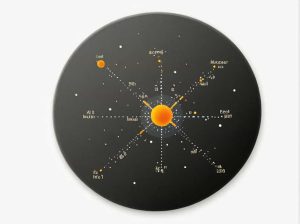Cepheid variable stars are some of the most important objects in astronomy. These pulsating stars change in brightness over time, following a predictable pattern. Their unique behavior has helped astronomers measure vast cosmic distances and understand the scale of the universe.
In this topic, we’ll explore what a Cepheid variable is, how it works, and why it’s crucial for astronomy.
What Is a Cepheid Variable?
A Cepheid variable is a type of pulsating star that expands and contracts in a regular cycle. This causes its brightness (luminosity) to change over a specific period.
These stars are named after Delta Cephei, the first one discovered in the constellation Cepheus in 1784 by John Goodricke.
Characteristics of Cepheid Variables
Cepheid variable stars have three main characteristics:
- Regular Brightness Changes – They brighten and dim in a predictable cycle, usually lasting from a few days to months.
- Direct Relationship Between Period and Luminosity – The longer the period of pulsation, the brighter the star.
- High Luminosity – Cepheid variables are much brighter than the Sun, making them visible over great distances.
Why Do Cepheid Variables Pulsate?
The pulsation of Cepheid variables is caused by a process known as the kappa mechanism. Here’s how it works:
- The outer layers of the star trap heat, causing them to expand.
- As the star expands, it cools and becomes dimmer.
- Eventually, the outward force weakens, and gravity pulls the layers back in.
- This compression causes the star to heat up and become brighter again.
This cycle continues in a regular, repeating pattern.
Types of Cepheid Variables
There are two main types of Cepheid variables:
1. Classical Cepheids (Type I)
- Found in the Milky Way and other galaxies
- More massive and luminous than Type II Cepheids
- Periods range from 1 to 100 days
- Used as standard candles to measure distances
2. Type II Cepheids
- Older and less massive than classical Cepheids
- Found in globular clusters and old stellar populations
- Usually have shorter pulsation periods
The Period-Luminosity Relationship
One of the most important discoveries about Cepheid variables is their period-luminosity relationship.
In 1912, Henrietta Swan Leavitt studied Cepheids in the Small Magellanic Cloud and found that the longer the pulsation period, the brighter the star.
This discovery means that if we know a Cepheid’s pulsation period, we can calculate its absolute brightness. Comparing this to its apparent brightness from Earth, we can determine its distance.
How Cepheid Variables Help Measure the Universe
Cepheid variables act as cosmic yardsticks for measuring astronomical distances. Here’s how they are used:
- Within Our Galaxy – Cepheids help determine distances to nearby star clusters and regions of the Milky Way.
- In Other Galaxies – Cepheids in neighboring galaxies allow astronomers to calculate the distance to those galaxies.
- Determining the Hubble Constant – By measuring Cepheids in distant galaxies, astronomers estimate the expansion rate of the universe.
Famous Cepheid Variables
Several Cepheid variables have played key roles in astronomical discoveries:
- Delta Cephei – The original Cepheid variable, located in the Cepheus constellation.
- Polaris (The North Star) – A Cepheid variable used for navigation and distance measurements.
- RS Puppis – One of the most luminous Cepheid variables, often studied for its pulsation effects.
The Role of Cepheid Variables in Astronomy
Cepheid variables have shaped modern astronomy in many ways:
- They helped prove that other galaxies exist – In the 1920s, Edwin Hubble used Cepheids in the Andromeda Galaxy to show it was a separate galaxy, not part of the Milky Way.
- They provided the first accurate cosmic distance scale – Before Cepheids, astronomers had no reliable method for measuring distances in space.
- They contribute to refining the Hubble Constant – Cepheid measurements continue to help determine how fast the universe is expanding.
How Astronomers Observe Cepheid Variables
Modern astronomers use powerful telescopes and instruments to study Cepheids:
- Hubble Space Telescope – Observes Cepheids in distant galaxies.
- James Webb Space Telescope (JWST) – Provides even more precise measurements of Cepheid distances.
- Ground-Based Observatories – Telescopes like those in Chile and Hawaii continue to monitor Cepheid variables.
Cepheid Variables and the Future of Astronomy
With advances in technology, Cepheid variables will continue to play a vital role in astronomy. Scientists are now:
- Using Cepheid data to refine the age of the universe.
- Studying Cepheid variables in even more distant galaxies.
- Improving techniques to measure the Hubble Constant more accurately.
Cepheid variables are among the most important stars in the universe. Their predictable brightness cycles have allowed astronomers to measure distances, map galaxies, and even determine the expansion of the universe.
Without Cepheid variables, our understanding of cosmology and the size of the universe would be far less developed. As telescopes improve, these pulsating stars will continue to guide us toward even greater astronomical discoveries.



